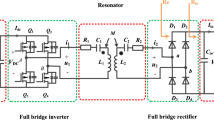Abstract
As an emerging research field, inductively coupled wireless power transfer (ICWPT) technology has attracted wide spread attention recently. In this paper, the maximum power transfer performances of four basic topologies labeled as SS, SP, PS and PP are investigated. By modeling the equivalent circuits of these topologies in high frequency (HF), the primary resonance compensation capacitances for maximum power transfer capability are deduced. It is found that these capacitances fluctuate with load resistance change, which is disadvantageous to SP, PS and PP topologies and an obstacle to their practical applications as well. To solve this problem, a phase controlled inductor circuit is proposed. By adjusting the triggering angle, the real-time dynamic tuning control can be achieved to guarantee maximum power transfer. Finally, simulations and experiments show that the proposed method is of great effectiveness and reliability to solve the issue of resonance compensation capacitance fluctuation with load change and to guarantee the flexible applications of all topologies.
Similar content being viewed by others
References
Tesla N. U.S. Patent 1119732, 1914
Boys J T, Green A W. Inductively coupled power transmission concept-design and application. IPENZ Trans, 1995, 22(1): 1–9
Manolatou C, Khan M J, Fan S H, et al. Coupling of modes analysis of resonant channel add-drop filters. IEEE J Quantum Electron, 1999, 35(9): 1322–1331
Hirai J J, Kim T W, Kawamura A. Wireless transmission of power and information for cableless linear motor drive. IEEE Trans Power Electron, 2000, 15(1): 21–27
Mandal T K. Wireless transmission of electricity development and possibility. In: Proceedings of Sixth international symposium Nikola Tesla. Belgrade, Serbia, October 18–20, 2006. 197–200
Soljačić M. Wireless energy transfer can potentially recharge laptops, cell phones without cords. Report in San Francisco Massachusetts Institute of Technology, 2006
Jang Y, Jovanovic M M. A contactless electrical energy transmission system for portable-telephone battery chargers. IEEE Trans Indus Electron, 2003, 50: 520–527
Hirai J J, Kim T W, Kawamura A. Wireless transmission of power and information for cableless linear motor drive. IEEE Trans Power Electron, 2000, 15(1): 21–27
Soljačić M, Kurs A, Karalis A, et al. Wireless power transfer via strongly coupled magnetic resonances. Sciencexpress, 2007, 112: 1–10
Fredy S, Jesús G C, Jordi S, et al. Wireless power of single-chisystems with integrated coil and external wire-loop resonator. Appl Phys Lett, 2008, 92(7): 074102 (1–3)
Imura T, Okabe H, Hori Y, et al. Basic experimental study on helical antennas of wireless power transfer for electric vehicles by using magnetic resonant couplings. In: Proceedings of Vehicle Power and Propulsion Conference, Dearborn, MI, 2009. 936–940
Zou Y W, Huang X L, Tan L L, et al. Current research situation and developing tendency about wireless power transmission. In: Proceedings of ICECE2010, Wuhan, China, 2010. 3507–3511
Tan L L, Huang X L, Li H, et al. Study of Wireless Power Transfer System Through Strongly Coupled Resonances. In: Proceedings ICECE2010, Wuhan, China, 2010. 4275–4278
Sample A P, Meyer D T, Smith J R. Analysis, experimental results, and range adaptation of magnetically coupled resonators for wireless power transfer. IEEE Trans Indus Electron, 2010, 99: 1–11
Tan L L, Huang X L, Huang H, et al. Transfer efficiency optimal control of magnetic resonance coupled system of wireless power transfer based on frequency control. Sci China Tech Sci. 2011, 54(6): 1428–1434
Yan G Z, Ye D D, Zan P, et al. Micro-robot for endoscope based on wireless power transfer. In: Proceedings of the 2007 IEEE international Conferrnce on Mechatronics and Automation. Harbin, China, August 5–8, 2007. 3577–3581
Jung K H, Kim Y H, Kim J, et al. Wireless power transmission for implantable devices using inductive component of closed magnetic circuit. Electron Lett, 2009, 45: 21–22
Fu W Z, Zhang B, Qiu D Y, et al. Maximum efficiency analysis and design of self-resonance coupling coils for wireless power transmission system. Proc CSEE, 2009, 29(18): 21–26
Sedwick R J. Long rang inductive power transfer with superconducting oscillators. Ann Phys, 2010, 25:287–299
Wang C S, Covic G A, Stielau O H. Power transfer capability and bifurcation phenomena of loosely coupled inductive power transfer systems. IEEE Trans Indus Electron, 2004, 51: 148–157
Zhou W Q, Ma H, He X N. Investigation on different compensation topologies in inductively coupled power transfer system. Trans China Electrotech Soc, 2009, 24(1): 133–139
Qiang H, Huang X L, Tan L L, et al. Study on topology design of wireless power transfer for electric vehicle based on magnetic resonance coupling. Adv Mater Res, 2011, 308–310: 1000–1003
Author information
Authors and Affiliations
Corresponding author
Rights and permissions
About this article
Cite this article
Qiang, H., Huang, X., Tan, L. et al. Achieving maximum power transfer of inductively coupled wireless power transfer system based on dynamic tuning control. Sci. China Technol. Sci. 55, 1886–1893 (2012). https://doi.org/10.1007/s11431-012-4847-0
Received:
Accepted:
Published:
Issue Date:
DOI: https://doi.org/10.1007/s11431-012-4847-0




